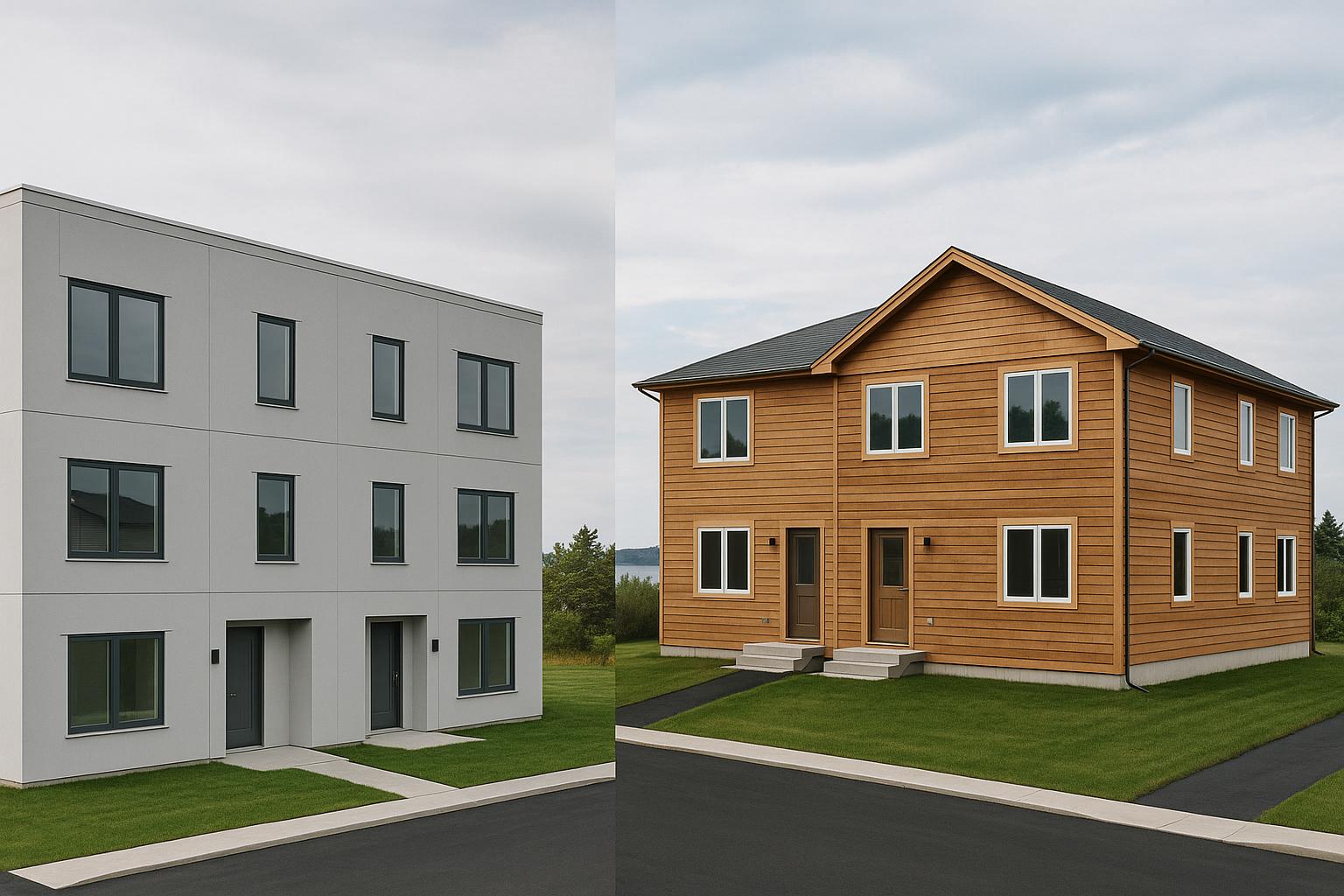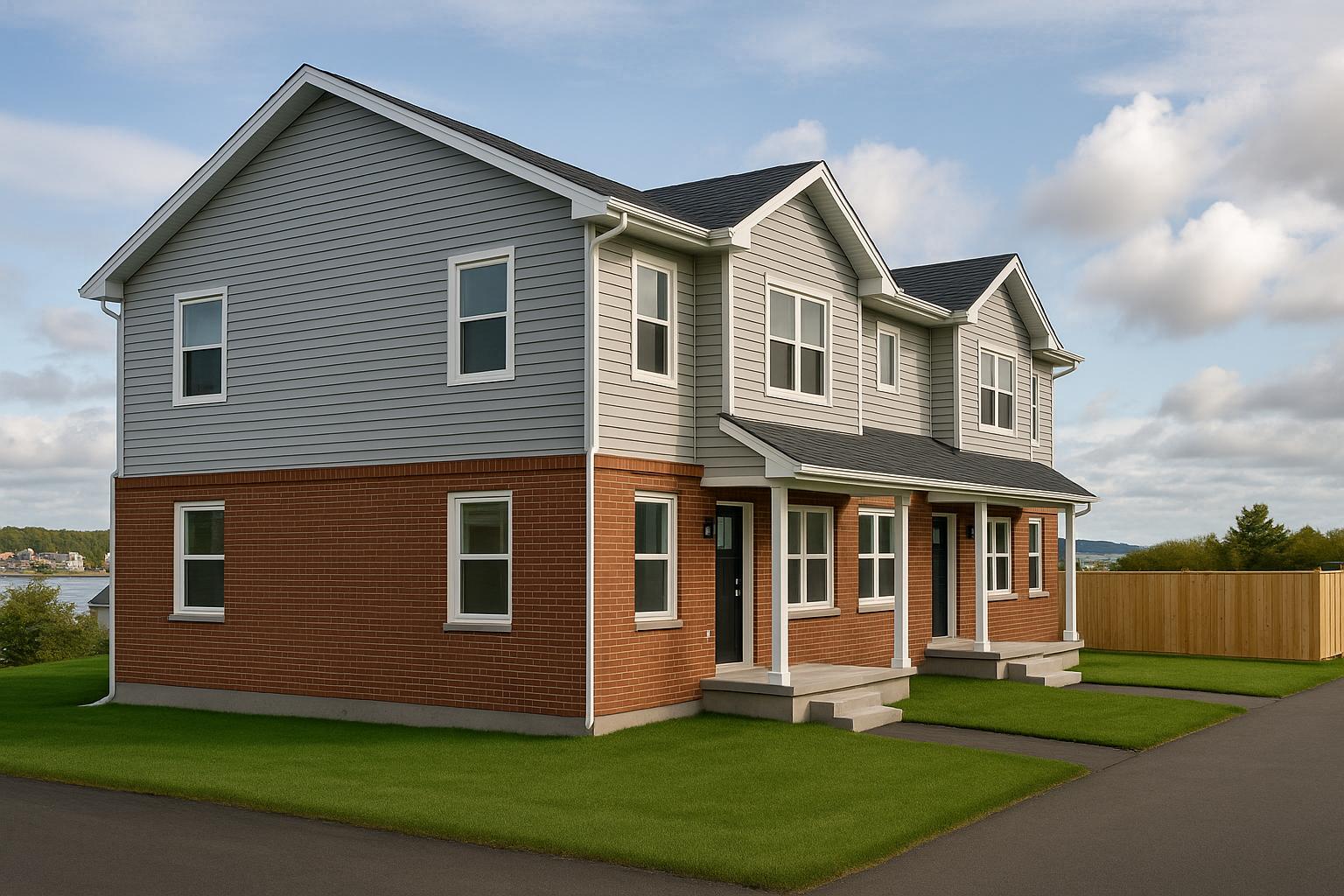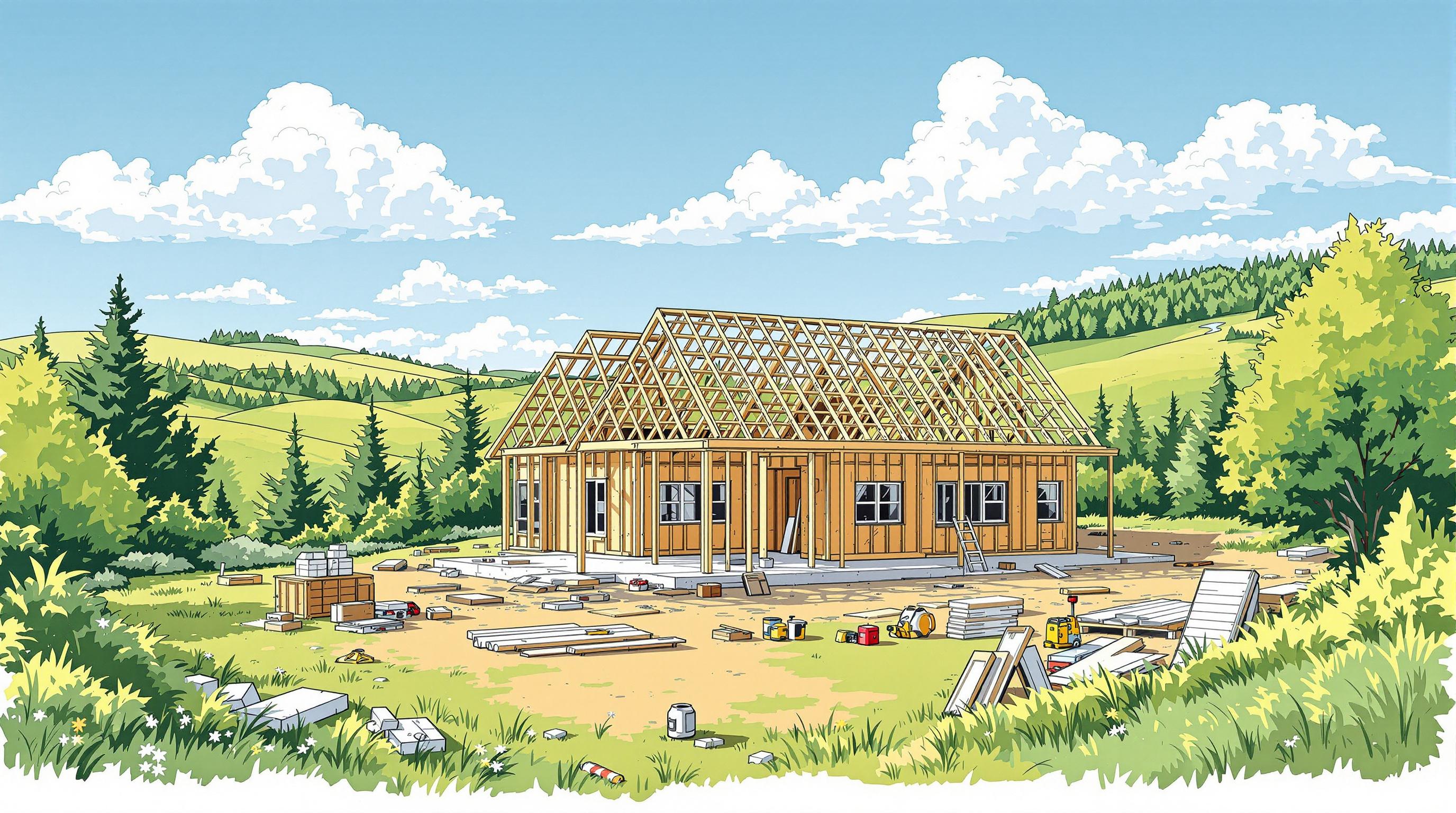Navigating Nova Scotia's energy compliance requirements for multi-unit rental properties can feel overwhelming. To secure permits, you need energy modelling during the design phase and blower-door testing after construction. These steps ensure your building meets energy efficiency standards under the 2020 National Building Code and updated 2024 provincial guidelines. Without passing both, your project can't move forward.
Key points:
- Energy Modelling: Digital analysis to predict energy performance, required before construction begins.
- Blower-Door Testing: Measures airtightness after construction to verify the energy model's accuracy.
- 2024 Updates: Include mandatory third-party reviews, digital submissions, and joint compliance certificates.
Helio simplifies this process with a bundled service that integrates energy modelling and blower-door testing into its fixed-price construction packages. This approach minimizes delays, avoids additional consultant fees, and ensures projects stay on schedule with a 6-month construction guarantee. Helio specializes in 4+ unit rental properties, offering predictable costs, streamlined timelines, and a single point of accountability.
Blower Door 101 - An Overview of Air Tightness Testing for Beginners
Permit Requirements: What Nova Scotia Municipalities Need
In Nova Scotia, municipalities have specific energy efficiency documentation requirements that must be met before construction and occupancy permits are issued. Here's a breakdown of the energy modelling and blower-door testing expectations.
Energy Modelling Requirements
When applying for a permit, you’ll need to submit a certified energy model. This document should outline the building’s thermal performance and HVAC specifications. Be sure to include critical details like HVAC equipment schedules, duct layouts, and ventilation calculations. Reports must be signed and sealed by energy consultants, detailing projected annual energy use, peak heating and cooling loads, and compliance with performance standards.
Most municipalities require that these models be completed by certified energy advisors holding current Natural Resources Canada credentials. The analysis must also reflect local climate conditions. If major design changes occur after the initial submission, you’ll need to provide updated compliance calculations and apply for permit amendments, which could delay processing. Next, let’s look at what’s required for blower-door testing.
Blower-Door Testing Requirements
Blower-door testing is carried out after the building’s structure is complete but before finishes are applied. This timing helps pinpoint air leaks early, allowing for corrections before finalizing construction. Certified building envelope professionals conduct the testing.
The results must confirm that the building meets the airtightness levels specified by municipal guidelines. Reports should include details of leak locations and may feature thermal imaging to identify problem areas like electrical penetrations, plumbing chases, and transitions in the building envelope. If the initial test doesn’t meet the required standard, additional sealing and retesting will be necessary.
2024 Changes to Permit Standards
Starting in 2024, Nova Scotia introduced several updates to permit standards. These include mandatory third-party reviews of energy models, digital submission of reports, joint compliance certificates, and pre-construction meetings.
Third-party verification now ensures greater accuracy in energy calculations before approval. Many municipalities have also transitioned to online portals for submitting energy modelling reports and blower-door test results, making the process more efficient.
Energy consultants and blower-door testing professionals must issue joint compliance certificates, confirming that the building’s measured performance aligns with the original energy model. There are stricter penalties for non-compliance, such as performance bonds that are only released once all testing and documentation requirements are met. For multi-unit projects, pre-construction meetings are now mandatory, involving permit applicants, energy consultants, and municipal inspectors to address potential compliance issues early on.
These updated standards underscore the importance of staying organized and working with professionals who can navigate the evolving requirements effectively. Helio’s integrated model, for instance, is designed to handle these changes seamlessly.
Step-by-Step Process: From Energy Model to Occupancy Approval
Navigating the journey from energy modelling to securing occupancy approval can feel complex, but understanding each step helps property owners stay prepared. Here's a breakdown of the key phases.
Adding Energy Modelling to the Design Phase
Energy modelling kicks off during the early design phase. At this stage, energy performance experts work closely with the owner and design team to identify ways to improve energy efficiency. Starting early allows for cost-effective adjustments before construction begins[1].
The process involves creating detailed energy models tailored to the project. These models are refined collaboratively to ensure compliance with the National Energy Code of Canada for Buildings (NECB). For Part 3 buildings in Nova Scotia, NECB compliance is mandatory for building permit applications[1]. This involves comparing the proposed design's energy performance to a reference building to confirm it meets provincial energy standards.
Incorporating energy modelling into the design phase ensures the project aligns with permit requirements. Bringing an energy consultant on board early ensures the modelling process supports your specific goals. Once the energy model is finalized, the next step is blower-door testing.
Scheduling and Completing Blower-Door Tests
After finalizing the energy model, the focus shifts to blower-door testing. This test is conducted once the building's structure and envelope are complete, but before interior finishes are added. Timing is critical - it allows any air leakage issues to be identified and resolved while access to the building envelope is still possible.
Blower-door testing requires coordination between your contractor, a certified building envelope professional, and municipal inspectors. During the test, air leakage rates are measured, and a written report of the findings is prepared[2]. If the building doesn't meet the required airtightness, additional sealing and retesting may be needed to achieve compliance.
Submitting Reports and Getting Approval
With energy modelling and blower-door testing completed, the final step involves submitting the necessary documentation. This includes a comprehensive evaluation report - commonly referred to as an "N file" (as built) - which supports the occupancy approval process[3]. The report typically involves a site visit to verify the as-built design, completion of EnerGuide software modelling, and the issuance of an EnerGuide label, which must be displayed during the final building inspection[3]. By this stage, all mechanical systems, ventilation equipment, plumbing fixtures, and appliances should be installed.
Don't overlook any additional requirements from local building by-laws[3]. Checking with your municipal permitting office ensures all conditions are met. Proper coordination of these steps helps prevent delays, ensuring your project remains on track and ready for occupancy approval.
sbb-itb-16b8a48
Helio's Bundled Approach: Energy Compliance Services Included

Helio takes the stress out of juggling multiple services by bundling energy modelling and blower-door testing into a single design-build package. This approach not only simplifies compliance but also provides clear, upfront pricing.
What Helio Offers to Property Owners
With Helio, property owners get a fixed-price construction package that includes energy compliance services as part of the deal. This means energy modelling happens during the design phase, while certified blower-door testing is handled during construction - all managed by one cohesive team.
Helio's in-house experts incorporate energy modelling early in the design process. By doing so, they ensure that critical design decisions align with energy standards, avoiding the delays that often come with hiring separate consultants.
For blower-door testing, Helio collaborates with skilled building envelope specialists and schedules tests at the ideal construction stage. Their project management system ensures precise timing, removing guesswork and keeping the project on track.
Helio offers two pricing options:
- Standard Construction: $160,000 per unit
- CMHC MLI Select Construction: $200,000 per unit (eligible for CMHC's 95% financing program)
Both options include all energy compliance services, providing property owners with a seamless experience.
Why Helio's Bundled Services Stand Out
Helio simplifies accountability - there’s no room for finger-pointing. Their 6-month construction guarantee, backed by financial penalties for delays, keeps projects on schedule and minimizes costly revisions. With bundled services, property owners avoid surprise fees and can aim for an annual ROI of 12–20%.
When the same team handles both construction and energy compliance, quality control improves significantly. Helio's builders understand the energy model requirements and apply them throughout the construction process, reducing the risk of failed blower-door tests.
Fragmented Approach vs. Helio's Integrated Model
| Aspect | Fragmented Approach | Helio's Integrated Model |
|---|---|---|
| Coordination | Multiple contracts with consultants, architects, engineers, and contractors | Single team manages design, construction, and compliance |
| Timeline | 12–18 months due to scheduling conflicts | Guaranteed 6-month completion with streamlined scheduling |
| Cost Structure | Extra consultant fees for energy modelling and testing | Fixed price includes all compliance services |
| Accountability | Finger-pointing between multiple parties | Single contract with financial penalties for delays |
| Quality Risk | Teams may not fully understand energy model requirements | One team creates the model and builds to its specifications |
This side-by-side comparison highlights how Helio's integrated model ensures consistent quality and timely completion. In contrast, fragmented approaches often lead to delays when consultants are unavailable or when design changes require updated models. Helio avoids these pitfalls by centralizing all services under one roof.
The financial benefits go beyond avoiding extra fees. Delays can eat into profits - imagine losing up to $8,800 per month in rental income for a fourplex. Helio's guaranteed timeline not only protects revenue but also ensures all permits are secured on time.
Making Compliance Simple for Property Owners
Energy modelling and blower-door testing don't have to be overwhelming. When done right, these steps not only protect your investment but also ensure your rental property meets Nova Scotia's energy standards.
Key Points for Property Owners
One of the biggest perks of working with an integrated builder like Helio is the predictability of costs and timelines. Instead of juggling multiple consultants, Helio offers a fixed-price package that takes care of everything - no surprise fees, no unexpected testing costs.
Their 6-month construction guarantee, backed by financial penalties of up to $1,000 per day for delays, keeps your project on schedule. On top of that, daily photo updates allow you to track progress on air sealing and insulation, giving you peace of mind and the chance to address potential issues before they escalate into expensive problems during testing.
This level of transparency and predictability makes Helio a smart choice, especially for multi-unit projects.
Why Helio Works for Multi-Unit Construction
Multi-unit rental properties come with unique energy requirements that differ from single-family homes. Helio specializes in 4+ unit rental properties, ensuring these specific needs are addressed from the start.
The company’s expertise stems from a strong foundation: co-founder Lloyd Liu brings financial insights from his time at Merrill Lynch, while co-founder Yuan He applies technical know-how from his data science background at the University of Pennsylvania. Together, they’ve developed a systematic construction process that avoids the typical miscommunications and delays that often arise between architects, engineers, and contractors.
With 31 units currently under construction and 131 more in planning across Nova Scotia, Helio’s track record speaks for itself. Property owners can anticipate 12-20% annual ROI on their rental properties, with units renting for $1,950-2,100 per month.
The alternative - managing separate contracts for design, engineering, energy consulting, and construction - can lead to costly delays and inefficiencies. For example, a fourplex sitting empty due to delays could cost you $8,800 per month in lost rental income. Helio’s single-contract approach, complete with built-in energy compliance, eliminates these risks entirely.
FAQs
How does Helio simplify compliance with Nova Scotia's 2024 energy efficiency standards?
Helio makes it easier to meet Nova Scotia's 2024 energy efficiency standards by incorporating energy modelling and blower-door testing right into their design-build process. These essential services are fully integrated, helping your project meet energy requirements without unnecessary delays or complications.
By managing these key steps internally, Helio takes the stress and uncertainty off your plate. Their efficient approach ensures your multi-unit rental project aligns with the latest regulations, speeding up the permitting process and keeping everything on track.
What happens if a building doesn’t pass the blower-door test after construction?
Failing a blower-door test can create serious challenges. For starters, it might delay occupancy approval if the building doesn't meet energy efficiency standards. This could mean unplanned expenses for extra air sealing or fixing leaks to bring the property up to code.
On top of that, not meeting energy codes can make the property less appealing to potential buyers or tenants, complicating efforts to sell or lease it. Fixing these problems after construction is not only more time-consuming but also tends to be far costlier than addressing them during the initial build.
How does Helio's integrated construction approach save time and money compared to traditional methods?
Helio takes a unified approach to construction, cutting delays and unexpected costs by an impressive 30–60%. Traditional methods often involve fragmented processes, making coordination tricky and expenses harder to predict. Helio’s model, on the other hand, delivers smoother project management with more dependable timelines and budgets.
By combining services like energy modelling and blower-door testing into one streamlined package, Helio removes the headaches of managing multiple contracts. This not only makes things easier for property owners but also ensures projects meet energy efficiency standards effortlessly - a game-changer for multi-unit rental developments in Nova Scotia.



